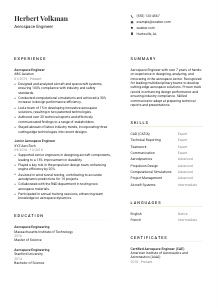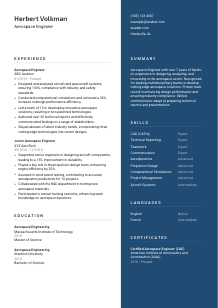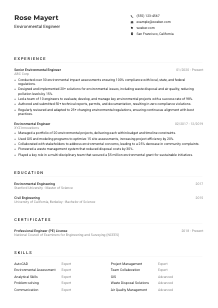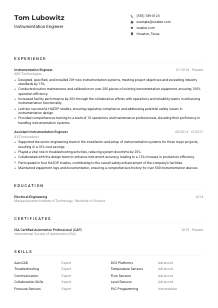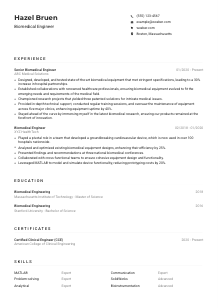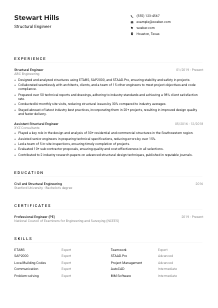Aerospace Engineer CV Example
Designing high-flying tech, but your CV not taking off? Propel your credentials with this Aerospace Engineer CV example, engineered using Wozber free CV builder. Learn how to align your aerodynamic expertise with the trajectory of job requirements, setting your career on a sky-high ascent.
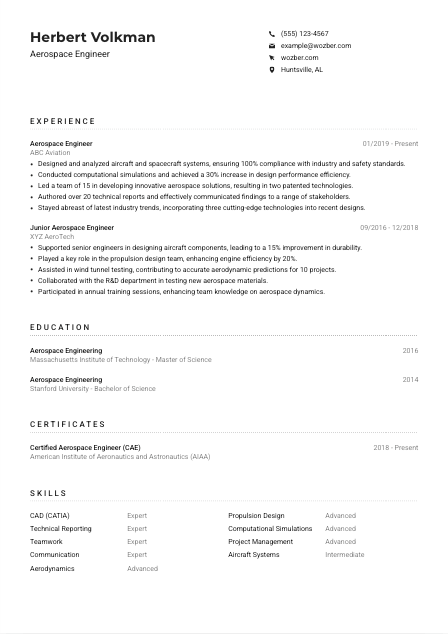
How to write an Aerospace Engineer CV?
Aspiring Aerospace Engineer, ready to launch your career sky-high? In the vast universe of job hunting, your CV is your rocket, meticulously engineered to land you in the cockpit of your dream job. With the Wozber free CV builder at your disposal, let's embark on a mission to create a CV that not only passes the ATS (Applicant Tracking System) gravitational pull but also lands directly in the hands of hiring managers.
Equipped with an ATS-friendly CV template and our ATS CV scanner, you're on the launchpad to success. Let's ignite the engines and prepare for takeoff!
Personal Details
First impressions count, especially when you're aiming for the stars. Your Personal Details section is the mission badge of your CV. It's more than just your identity; it's the first thing hiring managers see. Let's ensure it communicates the right information, clearly and effectively.
1. Name as Your Brand
Consider your name as the logo of your personal brand. Make it prominent, using a clear font. This isn't just a formality – it's the headline of your career story.
2. Your Role in the Stars
Directly below your name, position your targeted role, in this case, 'Aerospace Engineer.' This alignment with the job title instantly signals to the hiring manager that you're locked onto your career trajectory.
3. Contact: Establishing Communication Links
Your phone number and professional email (think firstname.lastname@email.com) are crucial. Double-check for typos to ensure the hiring team can contact you without any hiccups.
4. Location: Your Launch Site
Given the Huntsville, AL requirement, this detail confirms your readiness for the role without the need for relocation planning. It's a small but significant detail that aligns with the employer's logistical needs.
5. A Professional Portfolio
If applicable, add a link to your professional website or LinkedIn. These platforms offer a digital dimension to your CV, showcasing projects or endorsements that validate your expertise.
Takeaway
Your Personal Details are more than just information; they're the first handshake with potential employers. Make this handshake firm and confident by ensuring every detail is professional, relevant, and error-free. Think of it as your first step on the moon - make it count!





Experience
The Experience section is where you chronicle your flight path in aerospace engineering. It's your chance to highlight missions accomplished and showcase how you've soared in your career thus far. Let's make sure it's a stellar narrative.
- Designed and analyzed aircraft and spacecraft systems, ensuring 100% compliance with industry and safety standards.
- Conducted computational simulations and achieved a 30% increase in design performance efficiency.
- Led a team of 15 in developing innovative aerospace solutions, resulting in two patented technologies.
- Authored over 20 technical reports and effectively communicated findings to a range of stakeholders.
- Stayed abreast of latest industry trends, incorporating three cutting‑edge technologies into recent designs.
- Supported senior engineers in designing aircraft components, leading to a 15% improvement in durability.
- Played a key role in the propulsion design team, enhancing engine efficiency by 20%.
- Assisted in wind tunnel testing, contributing to accurate aerodynamic predictions for 10 projects.
- Collaborated with the R&D department in testing new aerospace materials.
- Participated in annual training sessions, enhancing team knowledge on aerospace dynamics.
1. Mission Analysis
Carefully examine the job description, identifying and noting the specific experiences that correlate with the responsibilities like 'design and analyze aircraft systems' and 'conduct computational simulations.' These are your mission objectives.
2. Mission Log
Format your experiences in reverse chronological order. For each position, list your title, the company, and the dates of your service. This ordered log makes your career trajectory easy to follow.
3. Achievements: Your Stars and Medals
Craft accomplishment statements that mirror the job's demands. Statements like 'Led a team in developing innovative aerospace solutions, resulting in two patented technologies' directly resonate with the job description.
4. Quantify Your Universe
Whenever possible, quantify your achievements. Did you improve design efficiency by 30% or author over 20 technical reports? These numbers are your medals of honor; wear them with pride.
5. Relevant Engineering Feats Only
While being a master at CAD software is relevant, your affinity for playing the guitar isn't. Filter your experiences to only those that propel your suitability for the Aerospace Engineer role. This isn't just about showing you're qualified, it's about showing you're the best fit.
Takeaway
Your experience section is a galaxy of your professional achievements. Each entry is a star, illuminating your path to this new opportunity. Remember, in the vast cosmos of applications, relevancy and clarity are your guiding stars. Keep your mission log focused and your achievements quantified, and you'll navigate through to the interview stage with ease.
Education
Your Education section isn't just a list of your academic accomplishments; it's the blueprint that shows the structural integrity of your foundational knowledge in aerospace engineering. Let's ensure this foundation is as impressive on paper as it is in reality.
1. Launchpad: Key Academic Requirements
Start by spotlighting the educational credentials that meet the job's prerequisites. Having a 'Bachelor's degree in Aerospace Engineering or a related field,' as specified, is your ticket to the launchpad.
2. Structure of Your Academic Satellite
Organize your education section in a clear and concise manner. Each entry should detail the degree, field of study, institution, and graduation year. This standardized format is your satellite's structural blueprint.
3. Custom Fitting Your Degree
It's essential to tailor your degree details to fit the job's requirements seamlessly. Highlighting your 'Master of Science in Aerospace Engineering' aligns perfectly with the job's preference for advanced education.
4. Advanced Training Modules
In specialized fields like aerospace engineering, relevant coursework, and special projects can set you apart. Mention those that are directly applicable to the job duties or demonstrate your ability to innovate within your field.
5. Honors and Extracurricular Projects
If you've been recognized for your academic excellence or have engaged in clubs or projects related to aerospace, highlighting these can add depth to your academic portfolio, showing a well-rounded and engaged professional.
Takeaway
Your education section is the foundation upon which your aerospace engineering career is built. It demonstrates your theoretical understanding and practical capabilities. Ensure this section is meticulously tailored to reflect not just your academic achievements but also your potential as an Aerospace Engineer. Align your education with the role's requirement, and you're one step closer to landing the job.
Certificates
Certificates in the aerospace field are like additional rockets on your CV - they provide that extra boost to your qualifications. While not always required, they show your dedication to continuous learning and mastery of specific skills. Let's see how to set these up for optimal propulsion.
1. Mission Briefing: Relevancy
Start by identifying certificates that are highly relevant to aerospace engineering, especially any that complement the job description. While the job post may not have listed specific certificates, showcasing ones like 'Certified Aerospace Engineer (CAE)' immediately draws attention.
2. Selecting Your Boosters
Highlight certificates that best fit the job requirements or add significant value to your profile as an Aerospace Engineer. It's about quality, not quantity: choose the ones that will give your application the most significant boost.
3. Certificates in Orbit: Dates Matter
Be clear about the validity of your certificates. If you've recently aced a notable certification, mentioning the date can emphasize your current expertise and ongoing commitment to the field.
4. Refueling and Upgrading
The aerospace industry evolves rapidly, and staying updated through certifications is crucial. Continually seek out new learning opportunities and certifications that will keep you at the forefront of aerospace innovation.
Takeaway
Certificates can significantly elevate your CV by showcasing your specialized skills and commitment to professional growth. They are your boosters in the journey toward your next aerospace engineering role. Be strategic in selecting these to ensure they add value and keep your application on an upward trajectory.
Skills
In the cockpit of your aerospace engineer CV, the Skills section is your control panel, full of knobs and switches that highlight your professional capabilities. This section must be finely tuned to reflect the skills most relevant to the job at hand. Let's ensure your control panel impresses the hiring managers.
1. Instrument Checklist: Required Skills
Start with a thorough review of the job description. Highlight skills such as 'Proficiency in CAD software' and 'Strong understanding of aerodynamics' to ensure your CV directly aligns with what the employer seeks.
2. Essential Controls
List technical skills and soft skills that match the job requirements. For an Aerospace Engineer, skills in 'CAD (CATIA)' and 'Technical Reporting' should be front and center, alongside 'Teamwork' and 'Communication.'
3. Streamlined Panel
Resist the urge to overload your skills section. Keeping it organized and focused on the most pertinent skills will make it easier for hiring managers and ATS systems to see you're a perfect match.
Takeaway
Your skills section is where you present your professional toolkit. It's crucial to customize this toolkit so it's clearly aligned with the job's requirements. Think of it as calibrating your instruments before a mission — precision here ensures a smooth flight toward your career goals.
Languages
In the global field of aerospace engineering, the ability to communicate across cultural and linguistic boundaries can be a valuable asset. Let's ensure the Languages section of your CV reflects not only your proficiency but also the scope of your interpersonal skills.
1. Mission Requirement: English Proficiency
The job requirements explicitly state a need for adeptness in English. Ensure your fluency level in English is clearly stated, marking it as 'Native' if applicable, to meet this crucial requirement.
2. Additional Language Modules
While the core requirement is proficiency in English, listing other languages can showcase your ability to engage with diverse teams and projects. Each additional language is like an extra module on your spacecraft, adding value to your mission capability.
3. Accurate Communication
Be honest and precise about your language proficiencies. Use terms like 'Fluent' and 'Intermediate' to accurately describe your level, ensuring expectations are clear from the start.
4. Analyzing the Mission Scope
When deciding which languages to include, consider the role's scope. If the position involves international collaboration or projects, highlighting your multilingual skills could be especially advantageous.
5. Universal Translator
Think of your ability to communicate in multiple languages as your personal universal translator. It demonstrates your readiness to engage in diverse environments and sets you apart as a global aerospace engineer.
Takeaway
Your fluency in multiple languages is a testament to your ability to operate in the increasingly global field of aerospace engineering. Highlighting these skills on your CV opens doors to new horizons and showcases your versatility. Remember, each language you speak is a bridge to another world of possibilities.
Summary
The Summary section of your CV is like the mission statement for your career. It gives hiring managers a quick, high-level view of who you are as an Aerospace Engineer. Let's craft a compelling narrative that encapsulates your experience, skills, and ambitions.
1. Mission Overview
Begin by understanding the core essence of the job you're applying for. Reflect on how your career path and achievements align with the role's responsibilities and what makes you an exceptional candidate.
2. Launch Sequence Initiated
Introduce yourself with a statement that highlights your professional identity and years of experience. For example, 'Aerospace Engineer with over 7 years of hands-on experience in designing, analyzing, and innovating in the aerospace sector.'
3. Trajectory Alignment
Incorporate skills and achievements that closely match the job requirements. Mention your proficiency in CAD software, aerodynamics understanding, and your role in leading teams to demonstrate your direct suitability for the position.
4. Orbital Insertion
Keep your summary concise yet powerful, aiming for 3-5 sentences. This isn't the full journey of your career but a high-level orbit, giving just enough to intrigue and encourage further exploration into your CV.
Takeaway
Your summary is your opportunity to assure hiring managers that their search ends with you. It sets the tone for everything that follows in your CV. By tailoring it meticulously to the job, you're signaling your readiness to take on the role of Aerospace Engineer with both expertise and enthusiasm. Let it reflect your ambition to reach new heights.
Mission Control: Launching Your Aerospace Engineer Career
Congratulations, Aerospace Engineer! You've now equipped your CV with the power to break through the stratosphere of the job market. By following these steps and utilizing the Wozber free CV builder, complete with ATS-friendly CV templates and ATS CV scanner, you've crafted a document finely tuned for ATS optimisation and human eyes alike. Go ahead, take command of your career journey. Remember, every great mission starts with a single step, or in your case, a single click.
Your landing site? The Aerospace Engineer role you've been dreaming of. Launch sequence commences now!

- Bachelor's degree in Aerospace Engineering or a related field.
- Minimum of 5 years of experience in aerospace design, testing, or analysis.
- Proficiency in CAD software such as CATIA or SolidWorks.
- Strong understanding of aerodynamics, propulsion, and aircraft systems.
- Effective communication and teamwork skills.
- Must be adept in English.
- Must be located in Huntsville, AL.
- Design and analyze aircraft and spacecraft systems ensuring compliance with industry and safety standards.
- Conduct computational simulations and physical tests to evaluate design performance.
- Collaborate with multidisciplinary teams to develop innovative aerospace solutions.
- Prepare technical reports, documentation, and present findings to both technical and non-technical stakeholders.
- Stay updated with the latest industry trends and technologies to ensure designs are cutting-edge.





